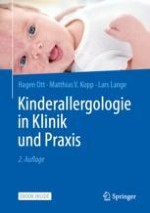2023 | OriginalPaper | Buchkapitel
7. Allergische Rhinitis und allergische Konjunktivitis
verfasst von : Prof. Dr. med. Matthias V. Kopp, Dr. med. Lars Lange, Prof. Dr. med. Hagen Ott
Erschienen in: Kinderallergologie in Klinik und Praxis
Verlag: Springer Berlin Heidelberg











